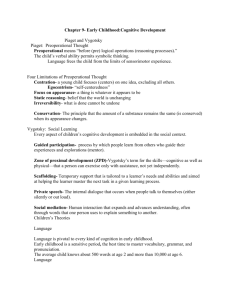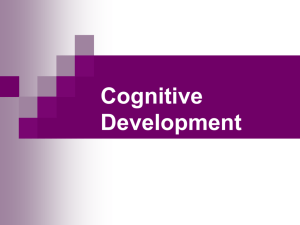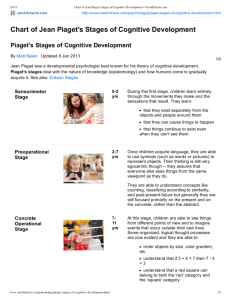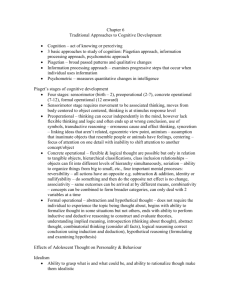PiagetsCognitiveDevelopmentTheory-123587749173
advertisement
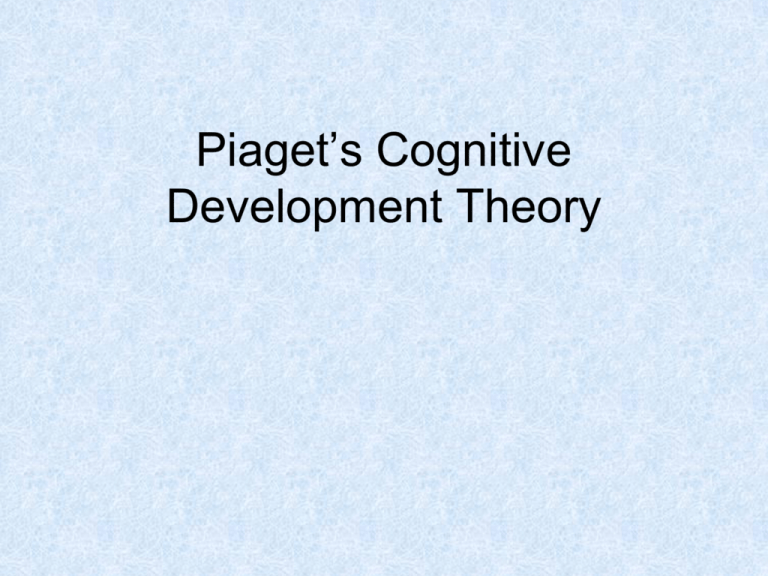
Piaget’s Cognitive Development Theory Who was Piaget? • Jean Piaget was born in 1896 in Neuchâtel, Switzerland, and died in 1980 in Geneva, Switzerland. • At age 11, he wrote a paper on an albino sparrow, which was published and was the start of his famous career. Who was Piaget? (cont.) • After graduating high school, he attended the University of Zurich, where he became interested in psychoanalysis. • He married in 1923 and had three children, Jacqueline, Lucienne and Laurent. • Piaget studied his children’s intellectual development from infancy. Theory of Cognitive Development • While studying his children, Piaget developed theories concerning how children learn. • His theory of Cognitive Development consists of four stages of intellectual development. Theory of Cognitive Development Click on link to hear Piaget speaking about his theory Jean Piaget Davidsonhttp://www.youtube.com/watch?v=lEam9lpa6TQ Stage 1—Cognitive Development Theory Sensorimotor Stage Birth to age 2 During this stage, the child begins to develop: • Reflexes • Habits • Hand-eye coordination • Object Permanence (knowing something exists, even though it can’t be seen) • Experimentation and creativity. Piaget referred to the children in this stage as “little scientists.” • Trial and error experiments Sensorimotor Stage Click on link to see demonstration of Sensorimotor Stage. YouTube - Piaget - Stage 1 - Sensorimotor, Object Permenence Stage 2—Cognitive Development Theory Preoperational Stage Age 2-7 During this stage, the child begins to develop: • Ability to represent objects with images and words • Language skills • Imagination Children learn through imitation and play during this stage. They begin to use reasoning, however it is mainly intuitive, instead of logical. Preoperational Stage Click on link to see demonstration of the Preoperational Stage. YouTube - Piaget - Stage 2 - Preoperational - Lack of Conservation Stage 3—Cognitive Development Theory Concrete Operational Stage Age 7-12 During this stage, the child begins to develop: • The fundamentals of logic – Ability to sort objects – Ability to classify objects – Understanding of conservation (physical quantities do not change based on the arrangement and/or appearance of the object) Concrete Operational Stage Click on link to see a demonstration from the Concrete Operational Stage. YouTube - Piaget - Stage 3 - Concrete - Reversibility Stage 4—Cognitive Development Theory Formal Operational Stage Age 11-15 During this stage, the child begins to develop: • Ability to hypothesize, test and reevaluate hypotheses Children begin thinking in a formal systematic way Formal Operational Stage Click on link to see a demonstration of a child in the Formal Operational Stage. YouTube - Piaget - Stage 4 - Formal - Deductive Reasoning How does this information apply to my teaching? Here are some practical ways to teach children in each of the four stages of Cognitive Development. Sensorimotor Activities (infant to Toddler) In the later steps of this stage, a child learns by trial and error. Therefore, providing a rich stimulating environment (rattles, blocks, etc.) is helpful. Peek-a-boo is also a helpful learning game in this stage. Preoperational Activities (Toddler and Early Childhood) Use illustrative visual aids to help children understand presentations. • Use physical props. • Use illustrations and artwork Preoperational Activities (Toddler and Early Childhood) Students have difficulty seeing the world from another perspective, other than their own. • Avoid lessons about worlds very different from the child’s. Preoperational Activities (Toddler and Early Childhood) Children need physical, hands-on practice with facts and skills needed for development. • Use cut-out letters to build words. • Do not use workbooks or paper and pencil activities very often. Preoperational Activities (Toddler and Early Childhood) Encourage hands-on activities with physical objects that change shape. This moves the child toward understanding conservation and two-way logic. • Have students play with clay, water, sand or play-dough. • Talk with students about what they are experiencing as they play with these objects. Concrete Operational Activities (Middle Childhood) Continue using visual aids and hands-on activities. • Give time lines for history lessons • Use 3-D models when teaching science. Concrete Operational Activities (Middle Childhood) Give students opportunities to manipulate objects and test out ideas. • Do simple science experiments, letting the students participate • Show craftwork to help students understand the occupations of people from earlier periods. Concrete Operational Activities (Middle Childhood) Students should not deal with more than three or four variables at a time. • Reading selections should have a limited number of characters. • Experiments should have a limited number of steps. Concrete Operational Activities (Middle Childhood) Explain complex ideas by using familiar examples, giving the students a way to understand and process new information. • Compare the lives of characters in a story with the students’ lives. • Use story problems when teaching math. Concrete Operational Activities (Middle Childhood) Give students opportunities to group and classify objects and ideas on complex levels. • Give students sentences on pieces of paper, have them group into paragraphs. • Use outlines and analogies to show the relationship of new material to already acquired knowledge. Concrete Operational Activities (Middle Childhood) Give students problems that require logical and analytical thinking in order to solve. • Use mind twisters, brain teasers and riddles. • Give students open-ended questions in order to stimulate their thinking. Formal Operational Activities (Adolescence) At the beginning of this stage, continue using the teaching strategies and materials used in the concrete operational stage. • Use visual aids, like charts and illustrations, but also incorporate a few more sophisticated graphs and diagrams. • Give step by step explanations and materials. Formal Operational Activities (Adolescence) Students need the opportunity to explore various hypothetical questions. • Students should discuss social issues. • Have students discuss hypothetical “other worlds.” Formal Operational Activities (Adolescence) Students should explain how they solve problems. • Students work in pairs, one is the listener, one is the problem solver. The problem solver works problem out loud, the listener checks to see that all steps are followed and seem logical. • Put a few essay questions on tests, which requires the student to give more than one final answer or simply answer from rote memory. Formal Operational Activities (Adolescence) Try and teach broad concepts, rather than just facts, and use material and ideas relevant to the students. • When teaching about Civil War, discuss other issues which have divided our country. • Use lyrics from popular music to teach poetry, to discuss social problems, etc. Theory of Cognitive Development Conclusion Keep in mind that children don’t always move from one stage to another at the same time. They will always move from one stage to the next in the same order, but you may have students in your classroom on different levels. Conclusion (cont.) There are many practical applications that can be made from Piaget’s theory. By using these in our teaching, we can hopefully teach students in a way that will help them be the most effective learners. References Giles, T. W. (March 1995). A Piagetian View of Learning Styles. 1-4. Huitt, W. (1997). Cognitive development: Applications. Retrieved November 15, 2008, from Educational Psychology Interactive: http://chiron.valdosta.edu/whuitt/col/cogsys/piagtuse.html Miller, S. A. (2007). Developmental Research Methods. In S. A. Miller, Developemental Research Methods (p. 405). SAGE. Nderu-Boddington, D. E. (May 2008). Theories of Intelligence, Learning, and Motivation as a Basis for Praxis. 1-17. Society, J. P. (2008, November 13). Jean Piaget Society About Piaget. Retrieved November 15, 2008, from Jean Piaget Society: www.piaget.org/aboutPiaget.html Thomas, W., & Kingma, J. (1996). Three Theories of Cognitive Representation and Their Evaluation Standards of Training Effects. 1-49.

